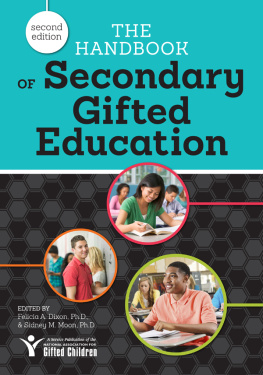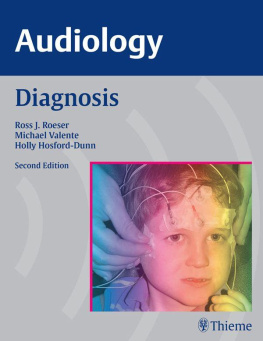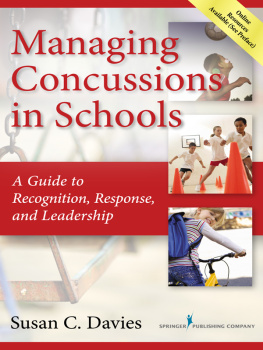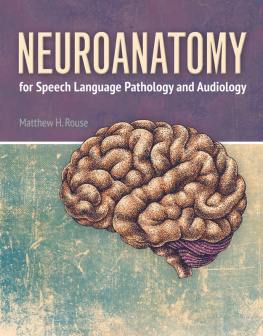Educational Audiology Handbook
THIRD EDITION

Editor- in-Chief for Audiology
Brad A. Stach, PhD

Educational Audiology Handbook
THIRD EDITION
CHERYL DECONDE JOHNSON, EDD
JANE B. SEATON, MS


5521 Ruffin Road
San Diego, CA 92123
e-mail:
Web site: https://www.pluralpublishing.com
Copyright 2021 by Plural Publishing, Inc.
Typeset in 10/12 Times LT Std by Achorn International
Printed in the United States of America by Integrated Books International
All rights, including that of translation, reserved. No part of this publication may be reproduced, stored in a retrieval system, or transmitted in any form or by any means, electronic, mechanical, recording, or otherwise, including photocopying, recording, taping, Web distribution, or information storage and retrieval systems without the prior written consent of the publisher.
For permission to use material from this text, contact us by
Telephone: (866) 758-7251
Fax: (888) 758-7255
e-mail:
Disclaimer: Please note that ancillary content (such as documents, audio, and video, etc.) may not be included as published in the original print version of this book.
Every attempt has been made to contact the copyright holders for material originally printed in another source. If any have been inadvertently overlooked, the publishers will gladly make the necessary arrangements at the first opportunity.
Library of Congress Cataloging-in-Publication Data
Names: Johnson, Cheryl DeConde, author. | Seaton, Jane B., author.
Title: Educational audiology handbook / Cheryl DeConde Johnson, Jane B. Seaton.
Description: Third edition. | San Diego, CA : Plural Publishing, Inc., [2021] | Includes bibliographical references and index.
Identifiers: LCCN 2019051643 | ISBN 9781635501087 (paperback) | ISBN 9781635501094 (ebook)
Subjects: MESH: Hearing Disorders | Child, Exceptional | Education of Hearing Disabled | School Health Services | Persons With Hearing Impairments | Audiologists | Professional Role
Classification: LCC RF290 | NLM WV 271 | DDC 617.8dc23
LC record available at https://lccn.loc.gov/2019051643
Contents
With Janet DesGeorges
With Lisa R. Cannon
With Erin C. Schafer
With Carrie Spangler
With Deanna K. Meinke
With Carrie Spangler
With Sarah Florence
It has been 22 years since the first edition of the Educational Audiology Handbook was published and eight years since the second edition. We are older, not sure if we are wiser, but we hope to have threaded throughout this third edition traditional practices with additional evolving practices that we feel are necessary to strengthen educational audiology services.
As in the past, this handbook focuses on the practice of audiology within the educational environment. We recognize that audiology practice settings, job descriptions, and employment conditions vary from state to state and district to district. However, we believe that educational audiologists are indispensable. In order to fulfill our role as advocates for students, educational audiologists should be consistent and participatory members of the multidisciplinary team whether that is in-person and/or remote. As a member of the team, responsibilities should be discussed and shared to ensure all relevant and necessary services are provided, particularly those related to access to communication and learning in the classroom.
New and Updated Content
This edition of the handbook includes information on legislation, and guidelines and procedures for educational audiologists and related professionals serving deaf and hard of hearing students in all learning environments. We are grateful to our contributing authors who have offered new perspectives on the topics of family partnerships (Janet DesGeorges), auditory processing deficits (Lisa Cannon), remote microphone technologies (Erin Schafer), wellness and social competence and support for the educational team (Carrie Spangler), prevention of noise-induced hearing loss (Deanna Meinke), and tele-audiology practice (Sarah Florence). In addition, Krista Yuskow, among others, have provided practical nuggets for everyday application of various components of educational audiology services.
Look for this icon throughout the text indicating Nuggets from the Field:  Overall, we have tried to emphasize the importance of improving outcomes for all children with auditory deficits, particularly with the increasing diversity in student demographics, performance, and learning environments. We also hope to move the focus on disability or deficits to wellness and promote a positive perspective of hearing and processing differences in order to align with school efforts to promote social-emotional well-being in all students. We believe that our students identities, self-esteem, and self-determination skills are all precursors to becoming effective self-advocates. While we recognize that it is the right of each person to determine how they would like their hearing status referenced (e.g., deaf, hard of hearing, hearing impaired, hearing loss), we have used terminology that refers to hearing levels or differences rather than losses whenever possible and appropriate. Lastly, we are very excited to endorse remote audiology services. We think some form of this model is in the future of most every educational audiologists practice.
Overall, we have tried to emphasize the importance of improving outcomes for all children with auditory deficits, particularly with the increasing diversity in student demographics, performance, and learning environments. We also hope to move the focus on disability or deficits to wellness and promote a positive perspective of hearing and processing differences in order to align with school efforts to promote social-emotional well-being in all students. We believe that our students identities, self-esteem, and self-determination skills are all precursors to becoming effective self-advocates. While we recognize that it is the right of each person to determine how they would like their hearing status referenced (e.g., deaf, hard of hearing, hearing impaired, hearing loss), we have used terminology that refers to hearing levels or differences rather than losses whenever possible and appropriate. Lastly, we are very excited to endorse remote audiology services. We think some form of this model is in the future of most every educational audiologists practice.
The handbook also has many links to resources at other websites. We guarantee that they all worked at the time of production. However, URLs change frequently, and we know this is frustrating. If a link does not work, try entering the first part of the link to get to the desired entitys home page and then search for a document.
Support for Educational Audiology Coursework
A new feature of this Handbook edition is that it is designed to serve as a textbook for educational audiology and other related coursework. The companion website contains a basic syllabus, and learning objectives, discussion questions, and PowerPoint slides for each chapter. We hope to provide students in AuD and other related programs (speech-language pathology, deaf education) with an appreciation for the practice of audiology in educational settings as well as the importance of teamwork and parent involvement when serving students who are deaf or hard of hearing.
Acknowledgments
In addition to our author contributors, we would like to recognize the students who contributed chapter page artwork. They are:
Allison, Mogadore, OH
Anec, Edmonton, Alberta, CA
Ben, Athens, GA
Billy, Mogadore, OH
Jaxen, Denver, CO
Nikayla, Edmonton, Alberta, CA
Sara Madeleine, Colorado Springs, CO
Sophia, Greeley, CO
Izabela, Justin, Rupert, Katie, & Emmy, Ohio high school students
Finally, we would like to acknowledge the spirit and work of all audiologists, especially those who devote their careers to working in the schools. The politics and resource limitations in education are challenging and require our constant vigilance. However, the gratification of working with students, parents, teachers, and other school professionals, and our ability to be involved in the lives of the children for such a critical part of their development yields countless rewards; perhaps why so many of us remain in our positions throughout our careers. We close with the following remarks, taken from the Educational Audiology Association List-serve, in response to a query for reasons to motivate graduate students in audiology about careers in educational audiology. They describe why we love what we do.
Next page











 Overall, we have tried to emphasize the importance of improving outcomes for all children with auditory deficits, particularly with the increasing diversity in student demographics, performance, and learning environments. We also hope to move the focus on disability or deficits to wellness and promote a positive perspective of hearing and processing differences in order to align with school efforts to promote social-emotional well-being in all students. We believe that our students identities, self-esteem, and self-determination skills are all precursors to becoming effective self-advocates. While we recognize that it is the right of each person to determine how they would like their hearing status referenced (e.g., deaf, hard of hearing, hearing impaired, hearing loss), we have used terminology that refers to hearing levels or differences rather than losses whenever possible and appropriate. Lastly, we are very excited to endorse remote audiology services. We think some form of this model is in the future of most every educational audiologists practice.
Overall, we have tried to emphasize the importance of improving outcomes for all children with auditory deficits, particularly with the increasing diversity in student demographics, performance, and learning environments. We also hope to move the focus on disability or deficits to wellness and promote a positive perspective of hearing and processing differences in order to align with school efforts to promote social-emotional well-being in all students. We believe that our students identities, self-esteem, and self-determination skills are all precursors to becoming effective self-advocates. While we recognize that it is the right of each person to determine how they would like their hearing status referenced (e.g., deaf, hard of hearing, hearing impaired, hearing loss), we have used terminology that refers to hearing levels or differences rather than losses whenever possible and appropriate. Lastly, we are very excited to endorse remote audiology services. We think some form of this model is in the future of most every educational audiologists practice.